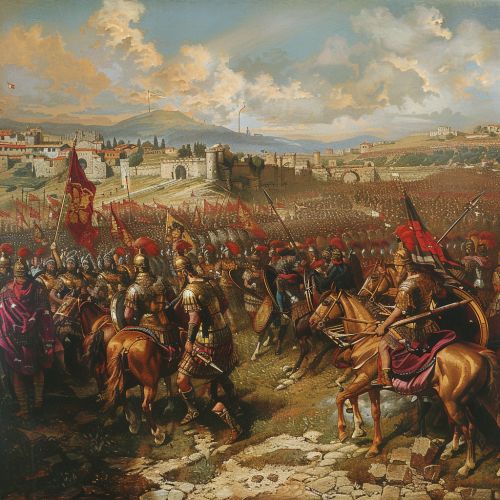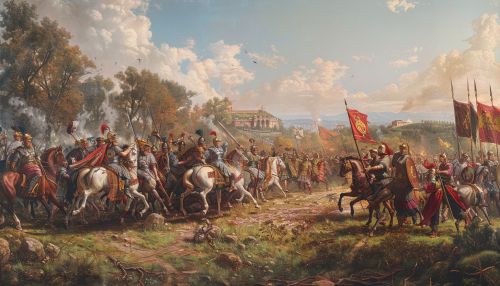Gothic War (376–382): Difference between revisions
(Created page with "== Background == The Gothic War (376–382) was a significant conflict between the Roman Empire and the Goths, primarily the Thervingi and Greuthungi tribes. This war marked a pivotal moment in the history of the Late Roman Empire, as it exposed vulnerabilities within the Roman military and administrative systems. The conflict began with the migration of the Goths across the Danube River, seeking refuge from the Huns, and culminated in the Battle of Adrianople in 378, o...") |
No edit summary |
||
| Line 21: | Line 21: | ||
The battle began with the Romans attempting to encircle the Gothic camp. However, the Goths, reinforced by their cavalry, launched a counterattack that overwhelmed the Roman forces. The Roman army was caught in a pincer movement, leading to a devastating defeat. Emperor Valens himself perished in the battle, and the Roman military suffered heavy casualties. | The battle began with the Romans attempting to encircle the Gothic camp. However, the Goths, reinforced by their cavalry, launched a counterattack that overwhelmed the Roman forces. The Roman army was caught in a pincer movement, leading to a devastating defeat. Emperor Valens himself perished in the battle, and the Roman military suffered heavy casualties. | ||
[[Image:Detail-93081.jpg|thumb|center|Depiction of the Battle of Adrianople, showing Roman and Gothic forces clashing on the battlefield.|class=only_on_mobile]] | |||
[[Image:Detail-93082.jpg|thumb|center|Depiction of the Battle of Adrianople, showing Roman and Gothic forces clashing on the battlefield.|class=only_on_desktop]] | |||
== Aftermath and Consequences == | == Aftermath and Consequences == | ||
Latest revision as of 23:14, 21 June 2024
Background
The Gothic War (376–382) was a significant conflict between the Roman Empire and the Goths, primarily the Thervingi and Greuthungi tribes. This war marked a pivotal moment in the history of the Late Roman Empire, as it exposed vulnerabilities within the Roman military and administrative systems. The conflict began with the migration of the Goths across the Danube River, seeking refuge from the Huns, and culminated in the Battle of Adrianople in 378, one of the most catastrophic defeats in Roman history.
Causes
The primary cause of the Gothic War was the westward migration of the Goths due to pressure from the Huns. The Huns, a nomadic group from Central Asia, began encroaching on Gothic territories around the mid-4th century. The Goths, unable to withstand the Hunnic onslaught, sought asylum within the Roman Empire. In 376, the Thervingi, led by Fritigern, and the Greuthungi, led by Alatheus and Saphrax, requested permission from Emperor Valens to settle in the Roman province of Moesia.
The Romans agreed to the Goths' request under the condition that they disarm and provide hostages. However, the Roman officials, particularly the provincial governors, mishandled the situation, leading to widespread corruption and exploitation. The Goths were subjected to severe mistreatment, including food shortages and extortion, which fueled resentment and ultimately led to rebellion.
Initial Stages of the War
The Gothic rebellion began in 377 when the Thervingi, under Fritigern's leadership, revolted against Roman authority. The initial skirmishes were marked by guerrilla tactics, with the Goths utilizing their knowledge of the local terrain to their advantage. The Roman response was hampered by internal divisions and the underestimation of the Gothic threat.
The Roman Emperor Valens, stationed in the Eastern Roman Empire, was preoccupied with conflicts in the East and initially delegated the Gothic problem to local commanders. However, as the situation deteriorated, Valens recognized the need for a more direct intervention.
The Battle of Adrianople
The Battle of Adrianople, fought on August 9, 378, was the most significant engagement of the Gothic War. Emperor Valens, eager to achieve a decisive victory, marched his army to confront the Goths near the city of Adrianople (modern-day Edirne, Turkey). Valens decided to engage the Goths without waiting for reinforcements from the Western Roman Empire, led by Emperor Gratian.
The battle began with the Romans attempting to encircle the Gothic camp. However, the Goths, reinforced by their cavalry, launched a counterattack that overwhelmed the Roman forces. The Roman army was caught in a pincer movement, leading to a devastating defeat. Emperor Valens himself perished in the battle, and the Roman military suffered heavy casualties.


Aftermath and Consequences
The aftermath of the Battle of Adrianople had profound implications for the Roman Empire. The loss of a significant portion of the Roman army and the death of Emperor Valens created a power vacuum and exposed the empire's vulnerabilities. The Goths, emboldened by their victory, continued to raid and plunder Roman territories.
In response, the new Eastern Roman Emperor, Theodosius I, adopted a more conciliatory approach. Recognizing the futility of continued conflict, Theodosius sought to integrate the Goths into the Roman system. In 382, a peace treaty was negotiated, allowing the Goths to settle in the Balkans as foederati, or allied tribes, with a degree of autonomy in exchange for military service.
Military Tactics and Strategies
The Gothic War highlighted significant differences in the military tactics and strategies of the Romans and the Goths. The Roman legions, traditionally known for their discipline and organization, struggled against the more mobile and flexible Gothic forces. The Goths employed hit-and-run tactics, leveraging their cavalry's speed and maneuverability.
The Battle of Adrianople underscored the importance of cavalry in late antiquity. The Gothic cavalry played a crucial role in their victory, demonstrating the limitations of the Roman infantry-centric approach. This battle marked a shift in Roman military doctrine, leading to increased emphasis on cavalry units in subsequent years.
Socio-Political Impact
The Gothic War had far-reaching socio-political consequences for the Roman Empire. The integration of the Goths as foederati set a precedent for the incorporation of barbarian groups into the Roman military and administrative structures. This policy of accommodation, while pragmatic, also led to increased tensions and cultural clashes within the empire.
The war also exposed the weaknesses in the Roman administrative system, particularly the corruption and inefficiency of provincial governors. The mistreatment of the Goths by Roman officials was a significant factor in the outbreak of hostilities, highlighting the need for reforms in governance and the treatment of subject peoples.
Legacy
The Gothic War (376–382) is often seen as a precursor to the eventual fall of the Western Roman Empire. The defeat at Adrianople and the subsequent integration of barbarian groups into the Roman system foreshadowed the empire's struggles with internal divisions and external pressures. The war also marked a turning point in Roman military history, leading to changes in tactics and the composition of the army.
The legacy of the Gothic War is evident in the continued presence of Gothic and other barbarian groups within the Roman Empire. The eventual establishment of the Visigothic Kingdom in the early 5th century can be traced back to the events of this conflict. The war also serves as a reminder of the complex interactions between the Roman Empire and the migrating barbarian tribes during late antiquity.
